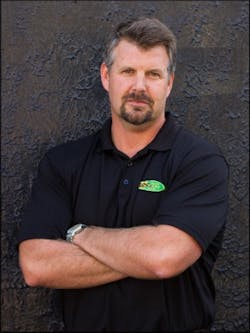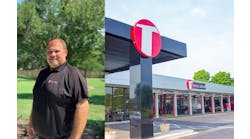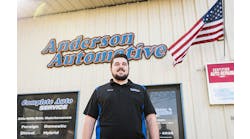The owner of a very successful local heating and air conditioning company drove into Patrick Connell's shop with a flat tire. What happened next wasn't pretty.
“I could see the look on his face when he saw all the trucks that were jammed in there,” Connell says. “There was no real organization. It looked like a facility that was trying to perform fleet work, but didn't have the right tools or equipment.”
There was serious danger in losing this client’s business—an entire fleet of vehicles that belonged to Connell’s shop, Automotive Repair Specialists. He was having trouble establishing his Wilmington, Del., business as a go-to source for local fleet work, and the small shop that was built for retail work was holding him back.
“To be in the fleet business, you have to be in the fleet business,” he says. “That means the right equipment, the right people, the right facilities. You have to commit to it.”
THE BACKSTORY
Connell’s always had a business-focused mindset, and he spent his childhood and teenage summers working in his family’s auto repair shop, prepping himself to one day take over Automotive Repair Specialists from his father, Armando.
But that day came sooner than Connell hoped—Armando unexpectedly suffered a stroke in 1999. Connell’s mother, Kathy, had to quit her full-time position as a nurse to care for Armando, and Connell was left to run the business and earn enough to pay for his father’s medical bills.
Armando had no disability to fall back on and there was a sudden influx of debt. Connell, 30 years old at the time, knew he’d have to make some serious changes at the $600,000-a-year shop to keep up with his parent’s payments.
With an interest in business-to-business relations, Connell had an idea: Add fleet services to his the shop’s offerings.
“Let’s go talk to one guy that might control 50 vehicles instead of sending out coupons to a guy that controls one or two cars and does $9 oil changes,” Connell said at the time.
ARS FLEET SERVICE
LOCATION: WILMINGTON, DEL.
SIZE: 20,000 SQUARE FEET
STAFF: 20 (8 TECHNICIANS, 5 DRIVERS, 3 ADMINISTRATIVE, 2 SERVICE WRITERS, 1 SERVICE COORDINATOR, 1 SALES REPRESENTATIVE)
AVERAGE MONTHLY CAR COUNT: 440
ANNUAL REVENUE: $4 MILLION
THE PROBLEM
Unfortunately, Connell’s plan wasn’t that easy to carry out. While he was able to add several fleet accounts to the shop’s workload between 1999 and 2005, the building his team operated out of didn’t fit the bill.
Connell was able to increase the shop’s annual revenue to $1 million by 2002 by altering the workload to 40 percent fleet work and 60 percent retail work—but his operation wasn’t exactly more efficient. Operating out of a 5,500-square-foot building with eight bays and eight employees, bays would have to double up for larger fleet vans and trucks, making repairs more inefficient.
THE OPTIONS
Connell wanted to make the leap to all-fleet, but his building wouldn’t suffice, and mathematically, he says it didn’t make sense to leave his retail customer base behind: His shop sat on a main road, and his database provided a basis for spending the time and marketing into growing his retail segment.
But, as far as Connell saw it, it wasn’t an option—to pay for his father’s medical bills, a major change had to be made. And since there were no dedicated fleet repair shops in town, he realized that with the proper marketing, he could sell a 100 percent fleet shop to area companies.
“We studied other service companies and commercial companies outside of the automotive industry,” he says. “What the best landscapers, plumbing and heating guys were doing to service people. And that’s what gave us the foundation. We can commit in this industry the way they have.”
On top of it all, time was of the essence. Not only were bills piling up, but Connell had come across what he calls a “perfect building” for his fleet shop: a 20,000-square-foot facility that sat in an industrial park where he could get more square footage for the dollar, and would allow him to add many more bays and stretch them from 8.5 to 14 feet wide.
THE SOLUTION
So, in 2006, Connell decided to make the transition, moving two miles away from the busy road and renaming the business ARS Fleet Service.
With wider bays, Connell carried over 30 percent of his old equipment and bought new 12,000-pound commercial lifts to handle fleet vehicles for the other 70 percent. He also set up a “triage area” to receive appliance vehicles at a moment’s notice.
“That was an entry point where each vehicle would come in and our service coordinator would get the necessary data and task accordingly to who was available and get it right into the production line.”
Knowing he’d have to slowly increase his staff as work piled up, he did the math:
“If you added 100 vehicles, that’s 400 visits per year. And then if you consider 20 percent breakdown rate, that’s 480 visits per year,” he says. “That’s a truck and a half a day. That allowed us to plan and be prepared for that.”
Connell knew he’d have to add more accounts to make up for the other 60 percent of lost retail business. He hired a sales representative that kept in constant contact with ARS’s current clients, while also reaching out to new potential partners in the area.
Connell targeted successful companies that had ownership and management teams onsite so he could reach out to the decision makers directly. That way, when a local business would visit ARS Fleet Services, they would no longer see clutter and disorganization—they’d see spacious, fully equipped shop.
“We wanted to market ourselves strategically. At every shop in town, everybody’s cars, fleet or non-fleet, would get put in same pile. Fleet vehicles would be sitting while retail customers are serviced,” he says. “That rang true to a lot of our clients. That’s what allowed us to leave that database and quickly create a new database of fleet customers.”
THE AFTERMATH
The numbers speak for themselves: Within six months, ARS had added enough accounts—which now stands at 250—to make up for lost retail work. And now, just nine years later, Connell has quadrupled the revenue of his former facility to $4 million by operating on an average of 440 vehicles per month. His staff of eight has grown to 20, which includes eight technicians and five full-time drivers to deliver and pick up vehicles starting at 5:30 a.m. every day.
The increased revenue and workload has come with a learning curve about scheduling and customer service for fleet accounts.
“The basis for our business is preventative maintenance,” he says. “If you take a company that has 100 vehicles, what we do for them is not only provide all the maintenance, but we also provide a level of management. We do all of those service reminders for those companies. We notify them on a bi-weekly basis which vehicles are due for which services. Then we schedule them accordingly throughout the month.”
Connell has also grown to understand the importance of fleet contracts. While a normal shop will schedule out its work, Connell must be ready to receive a client’s vehicles at a moment’s notice on top of the shop’s regularly scheduled fleet servicing.
“That’s one of the biggest challenges in the fleet business: When you have a client with 100 vehicles that might spend $250,000 a year with you and they have a vehicle that goes down, you can’t wait. That opens the window for them to take it somewhere else,” he says. “Our contracts are not binding. Our contracts are only based on what we will provide. That’s how we earn our spot at your company every single day.”
Expert Advice
WHAT MATTERS TO FLEET CUSTOMERS
Jonathan Conrad is the director of fleet operations for Horizon Services, one of the largest plumbing repair companies to service Kent County, where Patrick Connell’s fleet service shop resides. And with 400 trucks under his watch, keeping up with fleet maintenance goes hand-in-hand with keeping a close business relationship with ARS Fleet Service.
I’ve been running trucks for more than 20 years. So when I have a truck that’s going in there, Patrick gets every scrap of information about the vehicle he can. My GPS system is hooked into my truck, so if there’s anything going on, if you’ve got check engine lights on, I’ve already got the alert—and so does ARS. In turn, it cuts down on diagnostic time for them, and they can get parts ordered if they’re not stocked. He can turn work faster, which is great for us, and he can get more productivity out of his guys.
He started a night shift just to satisfy our capacity. It’s those unique perks that are crucial, that other people don’t offer, that are really important. I have a rolling night schedule that is done electronically that’s shared with Patrick. We arranged all of this together. We’re constantly in communication. We bounce ideas off each other all the time that will benefit both of our businesses.
I think the best way to put it is: He’s part of our business. He’s 100 percent on board with all his clients’ businesses. He’s a part of the process and he does whatever he can to try to streamline things for his clients, preventing downtime and reducing costs. For us, it’s awesome. He works on all my owners’ vehicles, and all of their families’ vehicles. That’s the type of relationship you want.
THE TAKEAWAY
Not only has Connell been able to pay his father’s medical bills by increasing the shop’s revenue fourfold, but he’s also been able to allow his parents to live a comfortable, retired life since overcoming the near-tragedy of his father’s stroke in 1999. And for Connell? His work is making him feel more fulfilled than ever before.
“It feels more like a business than an auto repair shop,” he says. “We now have a lot of interaction with other companies, other industries. We are creating solutions for companies that have transportation problems. It just continues to grow, and at the same time it provides me with what I need to take care of my parents.”



